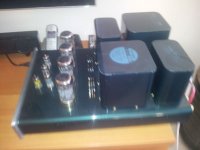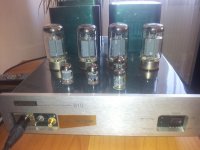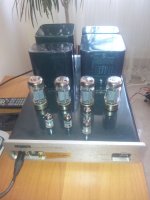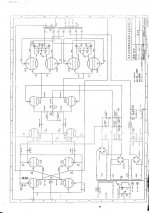All I can find
ºÏ·ÊÏèÉùµç×ÓÓÐÏÞÔðÈι«Ë¾£¬³§¼ÛÖ±Ïúµ¨»ú£¬µç×ӹܶú»ú·Å´óÆ÷£¬µç×Ó¹ÜÇ°¼¶·Å´óÆ÷£¬µ¨Ê¯»ìºÏ¹¦·Å¡¢¸ß±£ÕæÒôÏäµÈ¡£ - ÒôÏì֪ʶ - ÒôÏ쳣ʶ - Ãûµ¨KT88¡¢KT94¡¢KT100µÄÑݱä
It is a very simple design by the look of it, what is the issue?
ºÏ·ÊÏèÉùµç×ÓÓÐÏÞÔðÈι«Ë¾£¬³§¼ÛÖ±Ïúµ¨»ú£¬µç×ӹܶú»ú·Å´óÆ÷£¬µç×Ó¹ÜÇ°¼¶·Å´óÆ÷£¬µ¨Ê¯»ìºÏ¹¦·Å¡¢¸ß±£ÕæÒôÏäµÈ¡£ - ÒôÏì֪ʶ - ÒôÏ쳣ʶ - Ãûµ¨KT88¡¢KT94¡¢KT100µÄÑݱä
It is a very simple design by the look of it, what is the issue?
A friend has bought Spark 810, it's 15 year old or so, and needs recaping and retubing. The link you quoted leads only to the text (google translation):
" Spark another part of the body Dual Mono 810 Power Amplifier is a powerful, per channel with four the KT100 parallel work, the distortion output power up to 80W, in the ultra-high frequency of 20Hz to 50Hz, with a total harmonic distortion is less than 0.5 dB signal-to-noise ratio greater than 90 dB, are able to easily control most of the speakers in the world, because its output is enough momentum built up, in addition to outside to meet the most gall bladder fans appreciate, like listen to bursting with dynamic music enthusiasts also very tempting.
SPARK 810 tube amplifier circuit design is relatively new, the front a little-known "Chai Seoul" type inverting amplifier circuit (which features later adjourned to), the output signal is further amplified by double triode V3, add on the gate of the V4, V4 is a typical cathode output circuit, which input impedance is high, while the output impedance is very low, easy KT100 and final stage of the interface, so that the last stage and the pushing stage cross-linking is more reasonable. To make the machine work more stable and reliable, the KT100 cathode circuit with negative feedback, and the whole of the negative feedback loop circuit is also unique, it combines the features of the "Chai Seoul circuit balanced feedback technology, improvement of the sound quality has a significant positive effect. Now agreed to the consent of the Spark SPARK 810 circuit published reference system for harm.
-: Jin Weijie Source: "China Electronics Business"
" Spark another part of the body Dual Mono 810 Power Amplifier is a powerful, per channel with four the KT100 parallel work, the distortion output power up to 80W, in the ultra-high frequency of 20Hz to 50Hz, with a total harmonic distortion is less than 0.5 dB signal-to-noise ratio greater than 90 dB, are able to easily control most of the speakers in the world, because its output is enough momentum built up, in addition to outside to meet the most gall bladder fans appreciate, like listen to bursting with dynamic music enthusiasts also very tempting.
SPARK 810 tube amplifier circuit design is relatively new, the front a little-known "Chai Seoul" type inverting amplifier circuit (which features later adjourned to), the output signal is further amplified by double triode V3, add on the gate of the V4, V4 is a typical cathode output circuit, which input impedance is high, while the output impedance is very low, easy KT100 and final stage of the interface, so that the last stage and the pushing stage cross-linking is more reasonable. To make the machine work more stable and reliable, the KT100 cathode circuit with negative feedback, and the whole of the negative feedback loop circuit is also unique, it combines the features of the "Chai Seoul circuit balanced feedback technology, improvement of the sound quality has a significant positive effect. Now agreed to the consent of the Spark SPARK 810 circuit published reference system for harm.
-: Jin Weijie Source: "China Electronics Business"
Replace the valves by all means but why the capacitors, unless it has not been used for a few years but even then, a slow start up will help them recover.
I do like the write up translation. It is funny.
I do like the write up translation. It is funny.
Not so easy, the valves (those smaller) are soooo old, that symbols are almost unreadable... and how about setting bias, testing the current condition, etc, without schematic?
I have some Spark circuits. Do you have a photo of the amp.
I think I have the circuit for a kt100/kt88 that is a copy of the Mcintosh, cathode coupled.
I always run an amp that has not been used for some time with a light globe in the ac mains to recharge the Electrolytics
Phil.
I think I have the circuit for a kt100/kt88 that is a copy of the Mcintosh, cathode coupled.
I always run an amp that has not been used for some time with a light globe in the ac mains to recharge the Electrolytics
Phil.
Hi Phil,
thanks for your response.
Here are some photos:
thanks for your response.
Here are some photos:
Attachments
Last edited:
Hi Andy:
I should have the circuits will look today and if I find them scan the circuit.
I found they had design faults around the out put stage, very simple you just need to change a resistor, the way they are if one resistor blows, destroys the tube. With original Chinese tubes; the kt 100/88 used to short out very often no trouble with Russian 6550's or KT88's
Phil
I should have the circuits will look today and if I find them scan the circuit.
I found they had design faults around the out put stage, very simple you just need to change a resistor, the way they are if one resistor blows, destroys the tube. With original Chinese tubes; the kt 100/88 used to short out very often no trouble with Russian 6550's or KT88's
Phil
Spark 810
Hi Andy
Circuit for the 810.
I found when the amps were using chinese tubes they would often blow the resistor on the plate 33R and leave the SG intact destroying the tube, so you need to make sure the SG resistor blows before the plate 100r. With Russian tubes never had any problems. wonderful amps.
Hi Andy
Circuit for the 810.
I found when the amps were using chinese tubes they would often blow the resistor on the plate 33R and leave the SG intact destroying the tube, so you need to make sure the SG resistor blows before the plate 100r. With Russian tubes never had any problems. wonderful amps.
Attachments
- Status
- Not open for further replies.
- Home
- Amplifiers
- Tubes / Valves
- Spark 810 looking for the diagram



